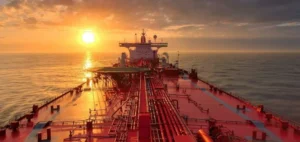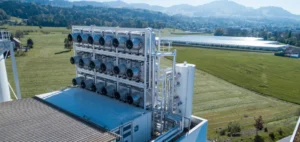The Norwegian government officially inaugurated this week the Longship industrial project, described as the world’s first integrated chain of carbon dioxide (CO₂) capture, transportation, and storage. This initiative, financially supported by the Norwegian state with 22 billion kroner (around €2 billion), is aimed at addressing emissions from industries challenging to decarbonize, such as cement production and waste incineration. Two primary industrial sites are initially involved in the project: the Heidelberg Materials cement plant in Brevik and the Hafslund Celsio waste incineration plant near Oslo. The process involves capturing CO₂ at source, liquefying it, transporting it by ship to the maritime terminal at Øygarden, near Bergen, and then injecting it deep beneath the seabed.
An Integrated Logistics Process
The first operational facility in the Longship project is the Brevik cement plant, owned by the German group Heidelberg Materials, capable of capturing approximately 400,000 tonnes of CO₂ annually. A second site, the Hafslund Celsio waste incineration plant, will begin operations in 2029 with an annual capture capacity of 350,000 tonnes. After capture, emissions are transported by ship to the Øygarden terminal. There, the CO₂ transits through infrastructure built under the Northern Lights project, managed by an energy consortium consisting of Equinor, Shell, and TotalEnergies, responsible for geological injection.
The Northern Lights facilities, operational since last year, currently have an annual storage capacity of 1.5 million tonnes of CO₂. This capacity is expected to gradually increase, reaching 5 million tonnes per year by 2028, enabling the site to accommodate emissions from other European industrial installations in the coming years.
Financing and Economic Model of the Project
The total investment required for the Longship project is estimated at around 34 billion kroner (approximately €3 billion), distributed between installation expenses and operating costs over an initial ten-year period. The substantial financial commitment by the Norwegian government, covering nearly two-thirds of the total cost, highlights the current economic complexity of carbon capture and storage (CCS) without public support.
This governmental backing directly addresses the economic challenge faced by industry: currently, it is generally more advantageous to purchase carbon emission allowances on the European Emissions Trading System (ETS) market than to invest in CCS technologies. Thus, the project’s profitability depends fundamentally on public subsidies and a scaling-up of storage capacities, which could generate economies of scale in the longer term.
Technological and Economic Challenges of CCS
Carbon Capture and Storage (CCS) remains a complex technology, involving industrial processes that are costly in terms of infrastructure. Globally, the total installed capacity for capturing CO₂ currently stands at around 50 million tonnes per year, equivalent to approximately 0.1% of annual global carbon emissions, according to the International Energy Agency (IEA). This illustrates the significant challenges industries face in adopting this technology without subsidies.
The Norwegian model precisely aims to address these challenges through implementing a complete and integrated industrial chain. Maritime transport of liquefied CO₂ over long distances to offshore sites represents a significant expense, though it allows centralization of flows to optimize geological storage management. This storage occurs by injecting CO₂ into a saline aquifer located approximately 110 kilometers offshore from the Norwegian coast, at a depth of 2,600 meters below the seabed.
European Interest and Prospects
The infrastructure established by Norway is also intended for use by other European industrial companies facing stringent regulatory objectives for carbon emission reductions. The planned expansion of Northern Lights to a storage capacity of 5 million tonnes annually could position it as a major European CCS hub, attracting industrial interest from other European countries subject to increasingly stringent regulatory constraints.
Several European companies, particularly from energy-intensive sectors such as cement production, steel, or chemical manufacturing, are already considering using Norway’s new geological storage infrastructure to meet their own climate obligations imposed by the European Union. Norway’s economic model, combining capture at source, maritime logistics, and offshore storage, may thus serve as a benchmark industrial solution within an evolving European regulatory context.






















